Audio
Video
Introduction
My favorite lessons and pearls from review articles published in September! Screening for primary aldosteronism, shigellosis, staph aureus bacteremia, and many more!
Subscribe to the Substack to get posts like this in your inbox!
Things We Do For No Reason - Failing to Consider Primary Aldosteronism in Hypertension (Journal of Hospital Medicine)
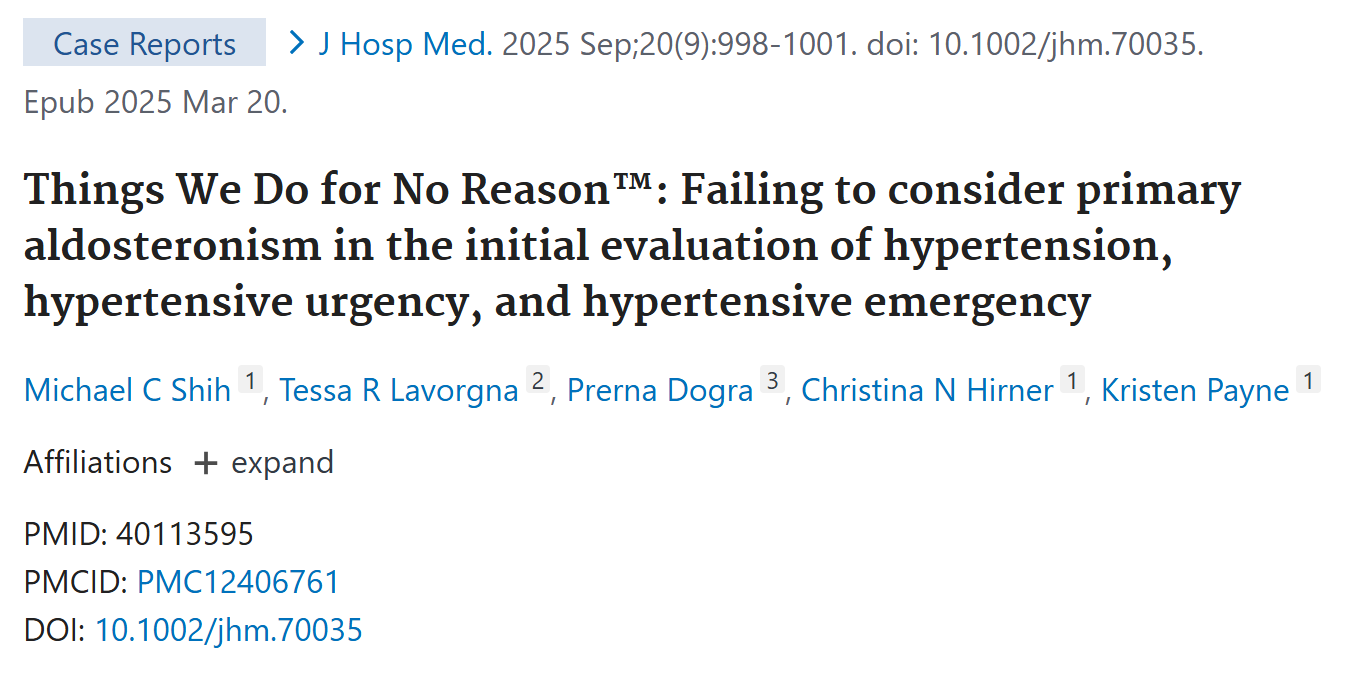
Source: https://pubmed.ncbi.nlm.nih.gov/40113595/
- Primary aldosteronism could be present in as many as 20% of people with hypertension, yet fewer than 3% of at-risk patients are tested
- Among those with primary aldosteronism 50%+ of patients experience diagnostic delay of >3 years
- Primary aldosteronism is more than HTN - high aldosterone can directly damage the heart, blood vessels, and kidneys through inflammation and fibrosis; this increases risk of cardiovascular events, renal dysfunction, mortality when compared to patients with essential hypertension with the same BP levels
- The myth of the washout period - belief that you need to hold anti-hypertensives for 4 weeks to screen is incorrect - there is a 96% sensitivitiy without a medication washout; it’s rare to have a false negative
- Should screen those with resistant hypertension (P >140/90 mmHg despite three drugs including diuretic, or controlled on four or more), HTN with hypokalemia, an incidental adrenal mass, or family hx of early-onset hypertension or stroke
- The preferred screen is aldosterone-renin ratio (ARR) - an ARR >20-30 with plasma aldosterone >10 and suppressed renin strongly suggests primary aldosteronism; send a morning plasma aldosterone concentration and renin (either plasma renin activity or direct renin concentration). It’s best to screen after ambulatory and potassium has been repleted (low potassium suppresses aldosterone secretion and can mask elevation)
- A positive screen should prompt referral to endocrinologist or nephrologist to confirm the diagnosis out of the hospital
Shigellosis Review - Lancet
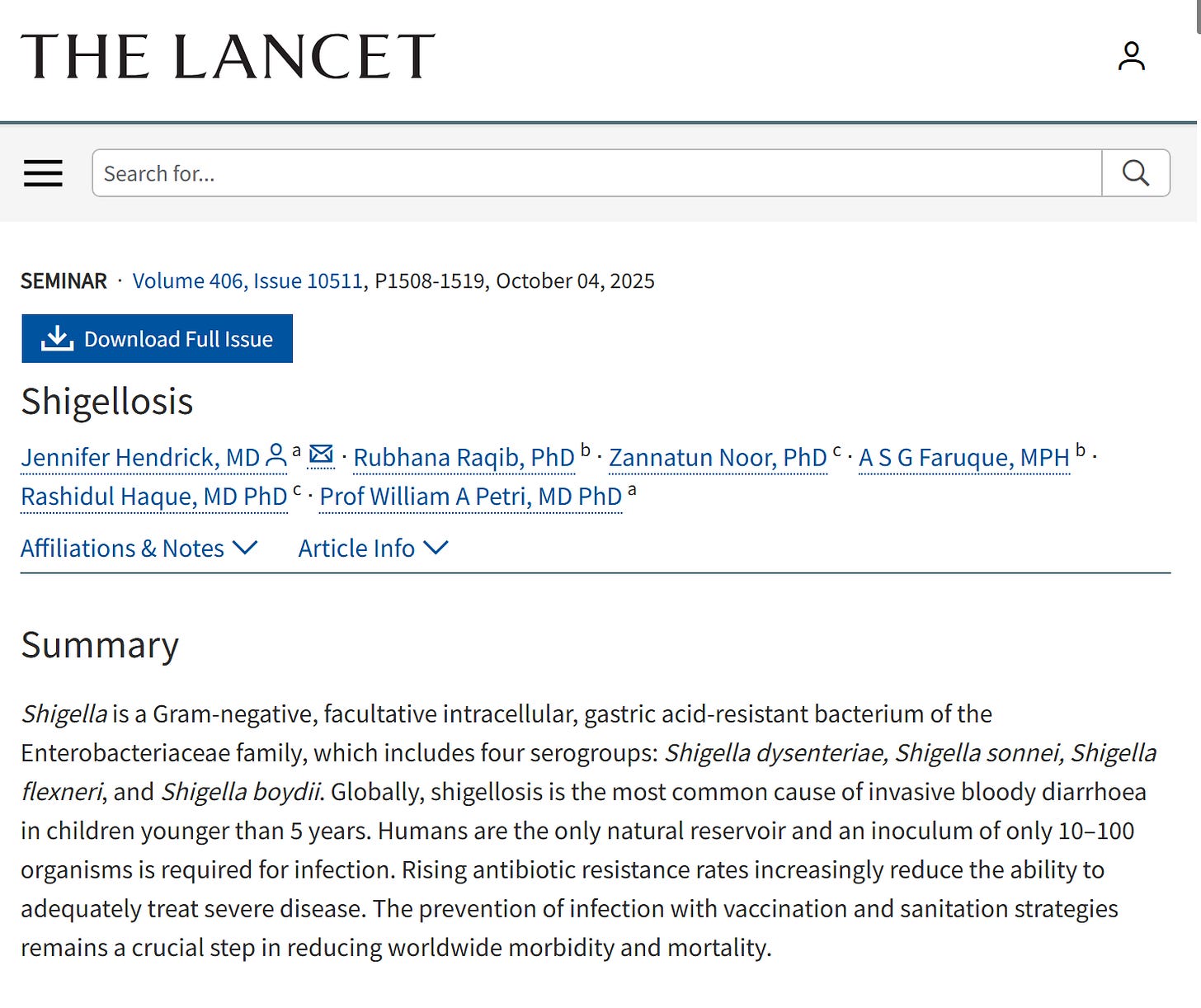
Source: https://www.thelancet.com/journals/lancet/article/PIIS0140-6736(25)01033-5/abstract
- Shigella is remarkably efficient due to resistance to gastric acid; a small inoculum (as few as 10-100 organisms) can get to the colon and cause an infection; it is spread via fecal-oral route
- Consider in patients with dysentery - frequent, small-volume, bloody and mucoid stools; often with fever, abdominal cramping, and tenesmus (painful, ineffective urge to defecate caused by rectal inflammation); these symptoms reflect bacterial invasion into the colon epithelium leading to an intense inflammatory response
- Shigellosis can cause seizures and hemolytic uremic syndrome (HUS) in children; HUS is only caused by shigella dysenteriae type 1 since it produces large amounts of shiga toxin
- PCR panels are useful for quick diagnosis; however, stool culture is valuable for resistance patterns; this is crucial in patients who are severely ill, immunocompromised, or in cases of an outbreak to ensure proper abx selection
- Antibiotic treatment is usually recommended to shorten the duration of disease and decrease fecal shedding; its almost always worth treating a patient in the hospital
- Ciprofloxacin was historically the most common tx, but resistance is now more common; inpatient IV ceftriaxone or oral azithromycin are often chosen
- Note that in MSM population, resistant strains are more common due to more frequent infection with S flexneri and S sonnei
Management of Staph Aureus Bacteremia Review (JAMA)
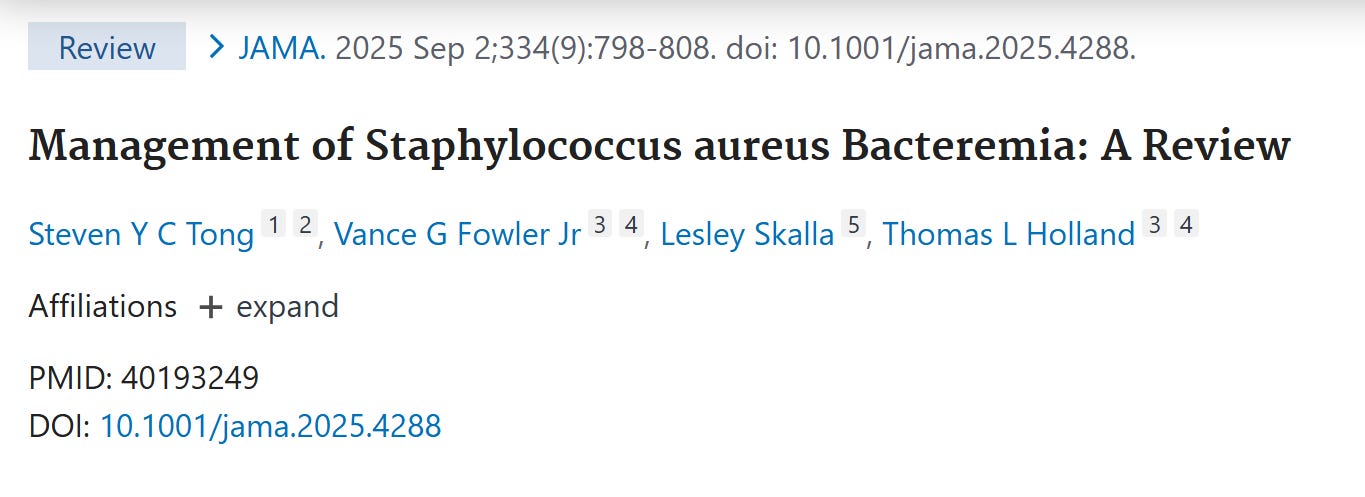
Source: https://pubmed.ncbi.nlm.nih.gov/40193249/
- Staph aureus bacteremia has mortality worldwide of almost 30%
- Metastatic infection present in more than 1/3 of patients - ex: endocarditis, vertebral osteomyelitis, septic arthritis
- Presentation often includes fever and symptoms related to metastatic focus (such as back/joint pain)
- Risk factors include intravascular devices (dialysis catheters, implantable cardiac devices), recent surgery, IVDU, diabetes
- Repeat blood cultures every 24 to 48 hours until clearance; if positive for more than 48 hours after treatment, concern for deep-seated infection
- All patients need TTE; TEE should be performed in those considered high risk - persistent bacteremia, prosthetic heart valves, intracardiac devices, new murmurs
- Empiric abx should cover MRSA - vanc or daptomycin
- MSSA should be treated with cefazolin
- Trials have failed to show improved outcomes with combination abx therapy over monotherapy
- Duration depends on complexity - minimum 2 weeks, 4-6 weeks for complicated infections including endocarditis or osteomyelitis
- Need source control - remove lines, implanted devices when able, drain abscesses, surgically debride or washout infected tissue
- Day 1 of abx starts either when source control is achieved, or day of first negative blood culture
- Given considerable nuances in diagnosis, abx selection, and duration - ID consult improves patient outcomes in observational studies
Lymphadenopathy Evaluation and DDx (AAFP)
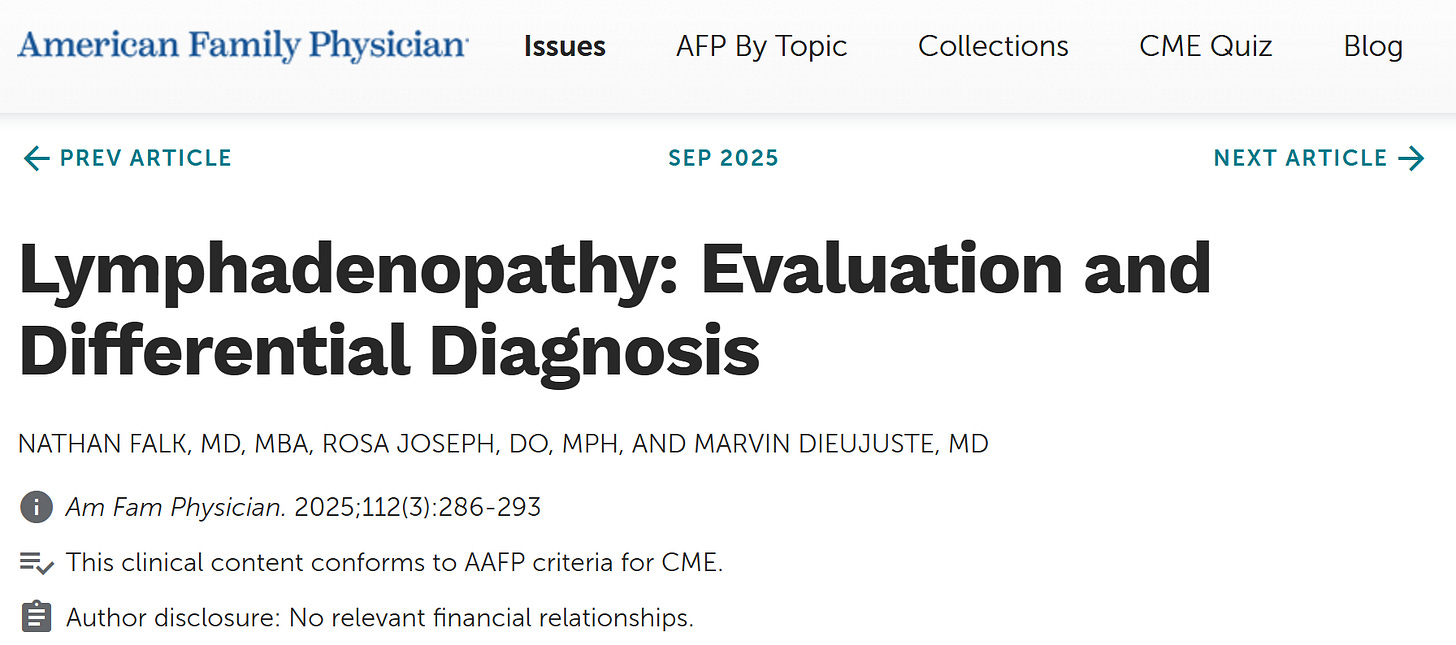
Source: https://www.aafp.org/pubs/afp/issues/2025/0900/lymphadenopathy.html
- Supraclavicular lymphadenopathy is strongly associated with malignancy
- Virchow’s node - left supraclavicular lymph node classically suggests primary malignancy below the diaphragm since it drains the thoracic duct
- Right supraclavicular lymph node points toward pathology in mediastinum, lungs, or esophagus
- Anterior lymph nodes are commonly reactive 2/2 pharyngitis
- Inguinal nodes are often enlarged from minor LE trauma or infections
- Generalized lymphadenopathy implies a systemic inflammatory process and requires a broad workup - defined as two or more non-contiguous lymph node regions
- Red flags on H+P include B-symptoms which are classic signs of lymphoma (fevers, drenching night sweats, unintentional weight loss >10% body weight over 6 months)
- Lymph nodes > 2 cm, or that are firm/rubbery (lymphoma) or rock-hard and fixed to underlying tissue (metastatic carcinoma) are concerning
- Lymphadenopathy that persists for more than 4 weeks warrants workup
- Ultrasound is preferred first-line test - can differentiate benign (oval, fatty hilum) from malignant (round, hypoechoic, absent hilum) features with high sensitivity
- In adults with high-risk features, unexplained cervical adenopathy, or supraclavicular nodes, a contrast-enhanced Computed Tomography (CT) scan of the neck, chest, abdomen, and pelvis is often necessary to evaluate for deep nodal disease and occult primary malignancy.
- In uncertain cases, or those concerning for malignancy, at minimum a core needle biopsy is needed; the gold standard is excisional lymph node biopsy to remove entire node and maintain architecture to get the most accurate diagnosis via histology, immunophenotyping, and molecular studies
- Many studies seem to imply core needle biopsy is adequate, but in my practice I commonly see non-diagnostic samples that then necessitate an excisional biopsy; workflow will often start with CNB inpatient to avoid needing anesthesia/surgery, and avoiding costs; the main exception is if there is concern for HL as some studies suggest CNB has led to higher false negative rates
- Avoid steroids in patients with undiagnosed lymphadenopathy - steroids are lymphocytotoxic and can induce rapid temporary shrinkage of nodes - provides a false sense of reassurance and even a false negative, non-diagnostic “ghost” biopsy
Large Vessel Vasculitis Review (Lancet)
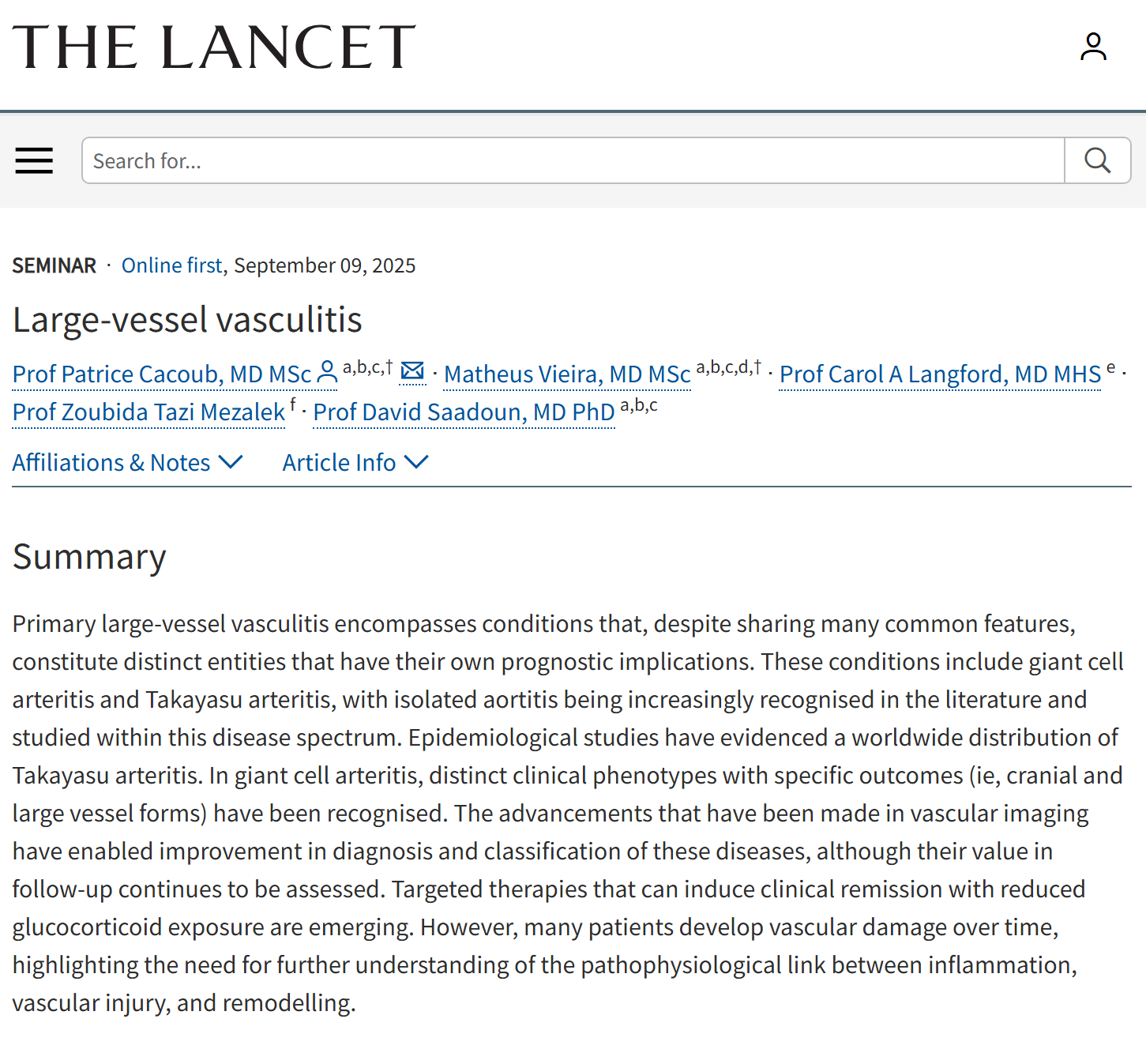
Source: https://www.thelancet.com/journals/lancet/article/PIIS0140-6736(25)01436-9/abstract?rss=yes
- GCA is not just a disease of the temporal arteries. The cranial phenotype presents with the classic headache, jaw claudication, scalp tenderness, visual disturbances. The large-vessel phenotype manifests with inflammation of aorta and major branches which can lead to limb claudication, asymmetric BP, aortic aneurysm, FUO. If GCA diagnosed, recommend getting CTA even if patient presents with purely cranial symptoms to evaluate for large-vessel disease.
- The most feared complication of cranial GCA is permanent vision loss from arteritic anterior ischemic optic neuropathy (A-AION) due to occlusion of posterior ciliary arteries
- Any patient over 50 with a compelling clinical picture - amaurosis fugax, diplopia, jaw claudication - should be started on pred 40-60mg daily; if presenting with active or evolving vision loss, IV methylpred 500-1000mg daily for 3 days is strongly recommended before oral steroids
- Diagnostic yield remains high for up to two weeks after starting steroids
- Ultrasound of the temporal and axillary arteries is a first-line imaging modality; the “halo sign” (non-compressible hypoechoic circumferential wall thickening) has high sensitivity and specificity for GCA. CTA and MRA can further reveal mural wall thickening, luminal stenosis, and aneurysmal dilation
- In the 2022 ACR/EULAR classification criteria, a positive “halo sign” or evidence of aortitis is weighted as heavily as a positive temporal artery biopsy, possibly allowing patient to forgo the need for an invasive procedure
- When compared with Takayasu arteritis, the main difference is demographics - GCA is a disease of older adults; Takayasu is a disease of younger, often Asian patients
- The GiACTA trial demonstrated efficacy of tocilizumab (IL-6 receptor inhibitor) along with steroid taper - higher rates of sustained steroid-free remission; in other words, it helps taper steroids faster and stay off them; hopefully avoids side effects of steroids
Hypothyroidism Review (JAMA)
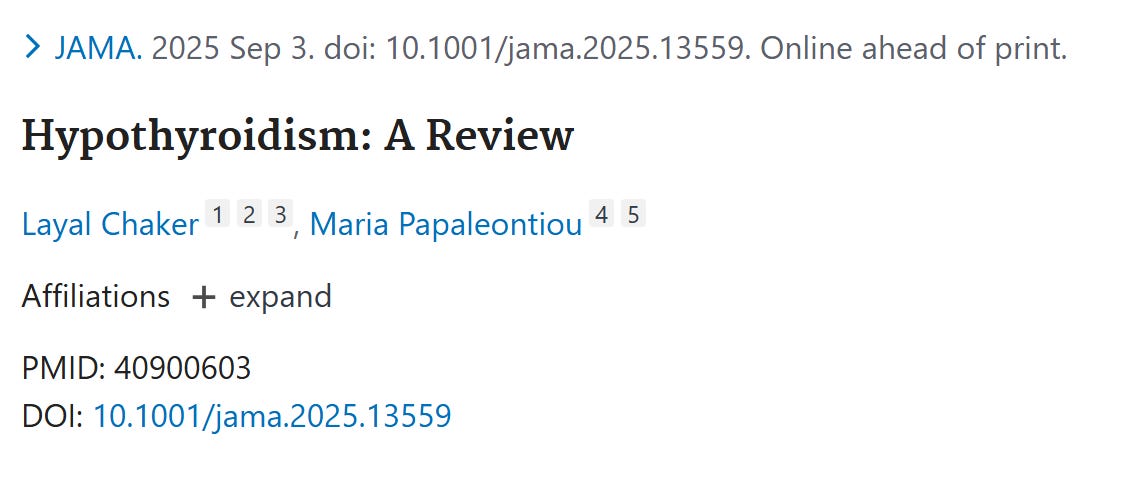
Source: https://pubmed.ncbi.nlm.nih.gov/40900603/
- Diagnosis is established with high TSH level with low free T4
- When the thyroid gland fails, the pituitary compensates by increasing TSH often before free thyroxine (fT4) levels fall below normal range
- Overt hypothyroidism has low T4 whereas subclinical hypothyroidism has normal T4
- T3 has no role in initial diagnostic workup - levels are often maintained until severe hypothyroidism
- Anti-thyroid peroxidase (TPO) antibodies can confirm Hashimoto thyroiditis, but is not necessary to start treatment
- Central hypothyroidism (less than 1% of cases) should be suspected in patients with low T4 and inappropriately normal or low TSH; often accompanied by other signs of pituitary dysfunction like adrenal insufficiency or hypogonadism; treatment monitoring in this case is based on T4 level instead of TSH which will always be low/normal. Also be mindful that TSH with reflex T4 screens may not be adequate to effectively diagnose, as TSH levels may be normal
- Young healthy patients can start levothyroxine with full replacement doses of 1.6 mcg/kg/day; in elderly or those with CAD start at 25-50 mcg daily
- The goal of treatment is to normalize the TSH without inducing iatrogenic thyrotoxicosis which can increase myocardial oxygen demand and lead to angina or arrythmias
- TSH levels should be checked in 6-8 weeks to allow for equilibration to a new steady state; changes should be made in increments of 12.5 to 25 mcg until TSH is within target range
- Euthyroid patients should have levels checked once a year to make sure levels are still appropriate
- Overtreatment and undertreatment are both serious; overtreatment can lead to AFib, decreased bone mineral density, increased fractures; undertreatment can lead to dyslipidemia, HTN, CAD
- Absorption and metabolism of levothyroxine is significantly affected by medications and effective treatment requires consistent absorption and metabolism. Calcium carbonate, iron sulfate, phosphate binders and PPIs can decrease absorption - the administration of these should be separated by at least 4 hours
- Levothyroxine should be given on an empty stomach, consistently timed with respect to meals and interacting medications
- Hepatic enzyme inducers such as carbamazepine, phenytoin, phenobarbital, and rifampin increase T4 clearance and may raise needed dose requirements. Sertraline may also do so. Estrogen therapy increases thyroxine-binding globulin and also necessitates higher doses.
- This is the reason pregnancy increases levothyroxine requirements early (more binding-proteins scoops up the free T4)
- Myxedema coma is more of a spectrum of disease than an all-or-none event - should be on your radar in elderly, chronically hypothyroid patients presenting with hypothermia, bradycardia, hypoventilation, hyponatremia, pericardial effusion, AMS, and some sort of trigger (infection, sedatives, cold exposure, surgery, MI).
- If you’re concerned about myxedema coma, draw a cortisol if possible, then begin treatment with steroids to address possible adrenal insufficiency as treatment with just levothyroxine can precipitate shock.
- Be mindful of euthyroid sick syndrome in the hospital - usually due to low T3, which is another reason it has no role in the initial diagnosis of hypothyroidism
- Enteral tube feeds should be paused for ~1 hour prior to Synthroid administration when able
- Nephrotic syndrome or protein-losing enteropathy can reduce binding proteins which alters free hormone levels, complicating interpretation
- High dose biotin (common in hair and nail supplements) can interfere with assays - often low TSH and high T4 which can mimic hyperthyroidism; should hold supplements for up to 48 hours prior to testing
- Amiodarone can impair peripheral conversion of T4 to T3 which can cause thyroid dysfunction
- Levothyroxine half-life is ~7 days; if a patient is NPO, missing a dose or two is usually safe; if missing considerably more than this, switch to a ~75% dose via IV
Hypertrophic Cardiomyopathy Review (NEJM)
Source: https://www.nejm.org/doi/full/10.1056/NEJMra2413445
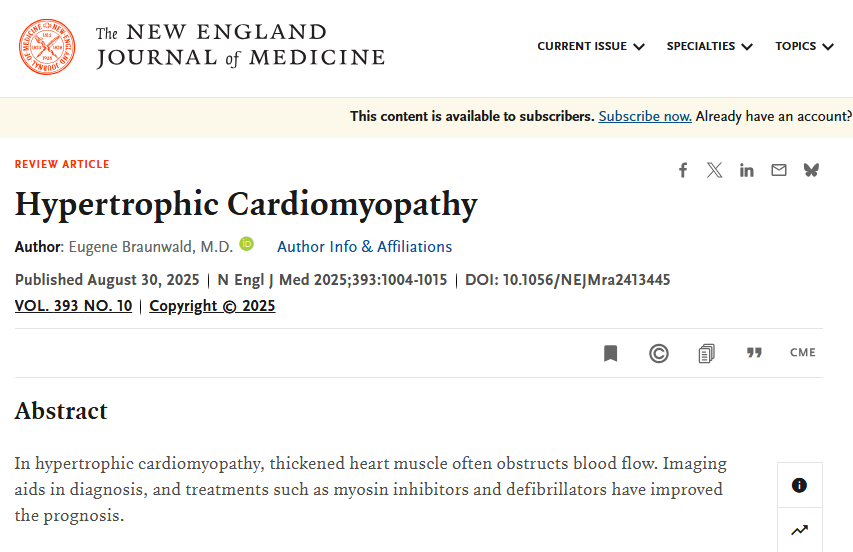
- Obstructive HCM is defined by dynamic LVOT gradient caused by septal hypertrophy and systolic anterior motion (SAM) of the mitral valve
- 70% of HCM is the obstructive form; however the obstruction is not fixed, but is rather a dynamic process
- The interventricular septum bulges into LVOT and anterior mitral valve leaflet moves toward septum during systole
- Obstruction worsens with any maneuver or medication that decreases preload (Valsalva, dehydration, standing, vasodilators like nitrates, dihydropyridine calcium channel blockers), or increases contractility (exercise, sympathomimetics like the pure inotrope digoxin); such meds should either be completely avoided or used with extreme caution
- Key factors that strongly favor ICD placement include: a family history of SCD attributed to HCM, massive left ventricular hypertrophy (wall thickness ≥30 mm), recent unexplained syncope, the presence of an LV apical aneurysm, and an ejection fraction <50%. Other important, though less definitive, markers include multiple or prolonged runs of nonsustained ventricular tachycardia (NSVT) on ambulatory monitoring and extensive late gadolinium enhancement (LGE) on cardiac MRI, which signifies myocardial fibrosis and scarring.
- Medical treatment is geared towards alleviating the LVOT gradient, and improving symptoms - first-line includes beta blockers, non-dihydropyridine calcium channel blockers (verapamil, diltiazem)
- Next, cardiac myosin inhibitors can be considered. Mavacamten and aficamten directly target the underyling HCM mechanism (mutations of sarcometic proteins the lead to excess of actin-myosin cross-bridges and hypercontractility). These drugs inhibit cardiac myosin ATPase, reducing the number of cross-bridges which decreses contractility and alleviates the LVOT obstruction.
- Landmark clinical trials like EXPLORER-HCM (mavacamten) and SEQUOIA-HCM (aficamten) demonstrated significant improvements in LVOT gradients, exercise capacity, and symptoms. The primary side effect to watch for is a decrease in EF which requires monitoring.
- AFib develops in 1/4 of HCM patients and can leads to issues with hemodynamics due to loss of the coordinated atrial kick reducing filling of the stiff LV. HCM patients should be on AC regardless of CHADS-VASc score given there is often left atrial enlargement which is prothrombotic.
- Septal reduction therapy (SRT) via myectomy (or alcohol ablation in older/frailer patients) is definitive treatment for medically refractory disease.
- Alcohol ablation injects ethanol into septal perforator coronary artery to induce a controlled MI and thus scarring and thinning of the basal septum.
- Practical Tips for the Hospitalist:
- Take care to avoid tachycardia, hypovolemia, and sudden drops in afterload. Practically, this means maintaining hydration, being more ginger with diuresis, avoid vasodilators, control pain/anxiety and fevers, and prioritize continuing rate control medication. If a pressor is needed, phenylephrine can raise afterload without stimulating the heart. Dobutamine and dopamine can worsen obstruction. Myosin inhibitors have a number of drug-drug interactions including azoles, macrolides, anticonvulsants - discuss with pharmacy.
Chronic Kidney Disease Review (Annals of IM)
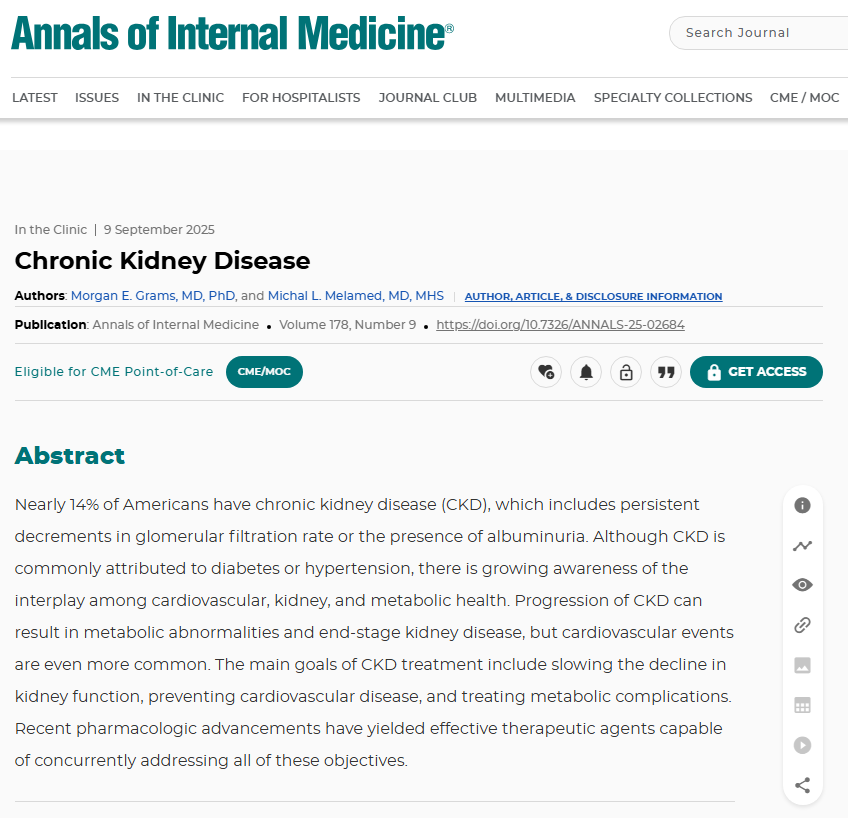
Source: https://www.acpjournals.org/doi/10.7326/ANNALS-25-02684
- CKD is staged by GFR and albuminuria which together predict the risk of progression and mortality.
- CKD requires evidence of kidey damage or decreased function for at least 3 months. Most commonly based on estimated glomerular filtration rate (eGFR) less than 60 mL/min/1.73 m2 OR a urine albumin-to-creatine rastio (UACR) > 30 mg/g.
- In cases of abnormal mucle mass or for more precise staging, combined creatinine-cystatin C equation is the most accurate method of calculating eGFR.
- Management is based on 4 pillers to slow progressiona and reduce cardiovascular risk
- RAAS inhibition
- SGLT2 inhibitors
- Nonsteroidal MRAs
- GLP-1 receptor agonists
- Patients with albuminuria should begin with RAAS inhibior such as ACE or ARB. These reduce intraglomerular pressure and proteinuria.
- SGLT2i are started regardless of T2DM status
- nsMRA like finerinone reduces CKD progression and cardiovascular events through anti-inflammatory and anti-fibrotic mechanisms and have a lower risk of hyperkalemia than steroidal MRAs (spironolactone)
- A majority of patients with CKD will die from cardiovascular disease rather than progressing to ESKD.
- Systolic BP target of <120 is guideline recommendation for most patients with CKD based on the SPRINT trial.
- Guidelines recommend statin for nearly all CKD or ESRD patients over age 50, regardless of baseline cholesterol based on the SHARP trial (note that it evaluated simvastatin and ezetimibe)
- Anemia is a near universal complication of advanced CKD, driven by decreased EPO production and impaired iron metabolism. Anemia of CKD requires iron repletion before considering erythropoiesis-stimulating agents (ESAs), as they are not effective without adequate iron. Oral iron is often started, but IV iron is often necessary. Goal of ESA is to address symptoms. The TREAT trial showed Hgb >13 did not lead to reduction in cardiovascular events, but did increase risk of stroke. General goal is Hgb level between 10-11.5 and NOT normalization of Hgb levels. Its a balance between addressing symptoms while maintaining safety.
- In the hospital, creatinine-based eGFR is unreliable measure of kidney function. Acute illness, inflammation, and muscle wasting reduce creatinine and thus eGFR likely overestimates actual kidney function which can lead to dangerous dosing errors in anticoagulants and antibiotics that are renally cleared. Cystatin C can provide more accuraste estimation.
- CKD patients have reduced renal reserve making them highly susceptible to AKI from NSAIDs, IV contrast, aminiglycosides and insults like hypovolemia or hypotension.
Practical Tips for Hospitalists
- Many admissions involve being too wet or too dry, and the kidney doesn’t like either. If diuresing, ceiling doses rise with lower GFR and augmentation is commonly needed. Electrolyte derangements (like HyperK) require lower threshold for action. Be cautious with hidden potassium loads like with potassium-sparing diuretics or a high-K diet. Magnesium-containing laxatives and antacids and phosphate enemas can swing electrolytes dangerously in patients with CKD. Discuss dose adjustments with pharmacy - avoid or dose-adjust baclofen, gabapentin/pregabalin, cefepime, morphine, codeine. Unfractionated heparin is easiest to start and stop when GFR<30. Apixaban is usually best DOAC option for long-term AC needs. Vancomycin requires kidney-informed dosing and level monitoring. Cefazolin given after dialysis is a common MSSA treatment. Insulin clearance falls as GFR drops making hypoglycemia a risk. In general, if a contrasted scan is needed, get it. If its not needed, avoid it. Hydrate as able if you are using contrast. Iron deficiency is common and IV iron can be helpful. Uremic platelet dysfunction may present as mucosal bleeding or oozing - desmopressin may be needed if procedures can’t wait. Pruritis and restless leg syndrome (RLS) may indicate high phosphorus; phosphate binders should be continued if the patient is eating. Vascular access is sacred - avoid PICCs in Stage 4-5 CKD in case fistulas are needed. Never place IVs, draw blood, or take BPs on the same arm as a fistula/graft. The RIJ is the preferred dialysis catheter site; needed central access should favor femoral or left-side of the neck. Uremia can cause encephalopathy. In peritoneal dialysis, abdominal pain is peritonitis until proven otherwise. ESKD patients should have their next chair time confirmed on DC.
Tumor Lysis Syndrome (TLS) Review (NEJM)
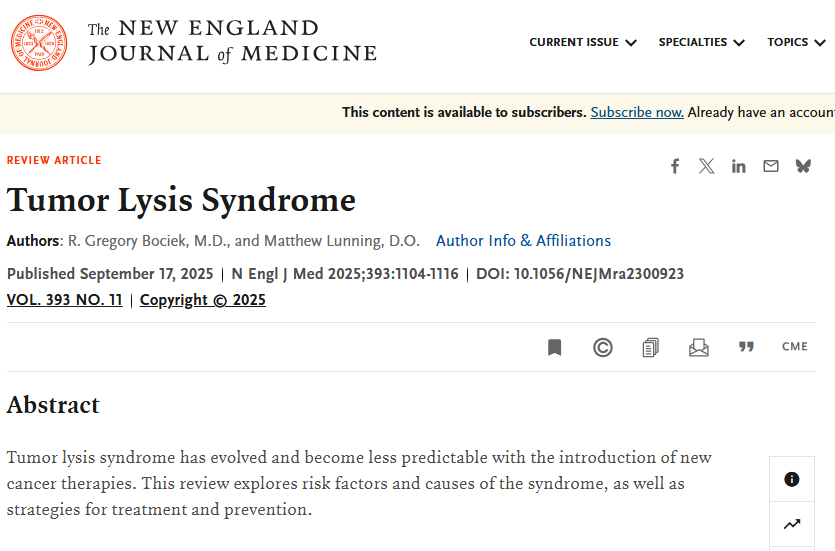
Source: https://www.nejm.org/doi/abs/10.1056/NEJMra2300923
- Cancers with the highest risk are bulky, highly proliferative, and chemo-sensitive hematologic malignancies like Burkitt lymphoma and acute leukemias (AML/ALL) with WBC >50-100k
- CLL is now often considered higher risk when treated with venetoclax
- Cairo-Bishop criteria distinguish between laboratory and clinical TLS
- Laboratory TLS is defined by 2 or more of the following any time between 3 days prior to and 7 days after treatment:
- uric acid >8
- K > 6
- Phosphorus > 4.5
- corrected calcium < 7
- a change of 25% or greater from baseline for any of the above
- Clinical TLS signifies end-organ damage requiring intervention - must have lab TLS AND one of the following:
- AKI
- Seizure
- Cardiac arrythmia or sudden death
- Aggressive IV hydration is the universal cornerstone for TLS prevention and management to excrete uric acid, potassium, and phosphate to minimize concentration in the renal tubules
- Urine alkalinization with sodium bicarbonate was historically recommended but is no longer standard practice, as it can worsen the precipitation of calcium phosphate crystals
- Rasburicase (a recombinant urate oxidase) metabolizes existing uric acid into allantoin; it creates hydrogen peroxide as a byproduct which can lead to hemolytic anemia and methemoglobinemia in patients with G6PD deficiency - screen before giving
- After giving rasburicase, it continues to work outside the body in blood samples (ex vivo); if you are measuring uric acid samples, they need to be placed on ice and run quickly after drawing - otherwise level will be low and will have false re-assurance
- Because we monitor it so closely and have medications to address it, uric acid is less likely to cause renal failure in the modern day. Hyperphosphatemia is now of concern as it can lead to precipitation of calcium phosphate crystals. While this can lead to hypocalcemia, avoid repleting calcium unless symptomatic (tetany, seizures, etc) since it can worsen renal precipitation

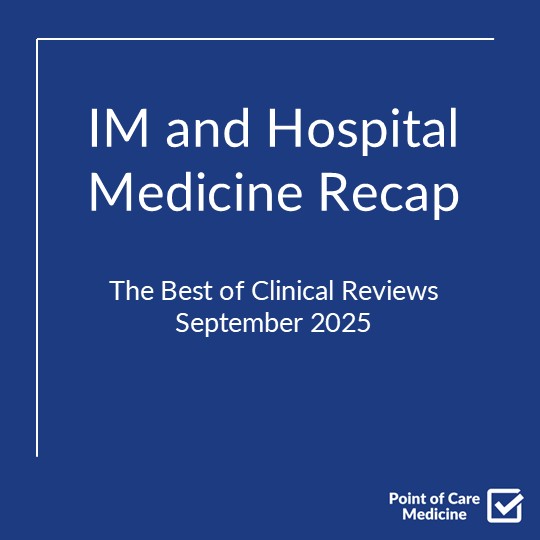
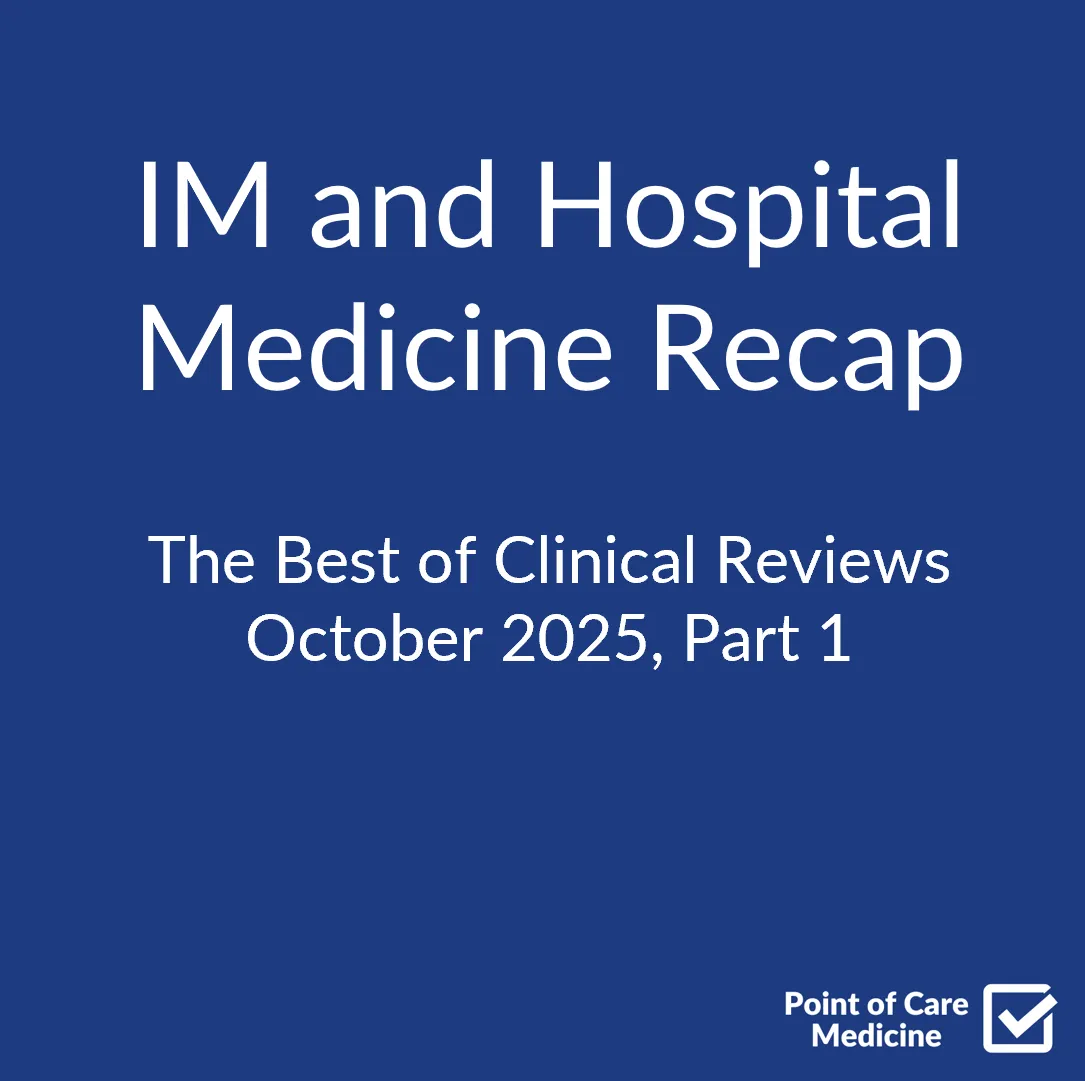
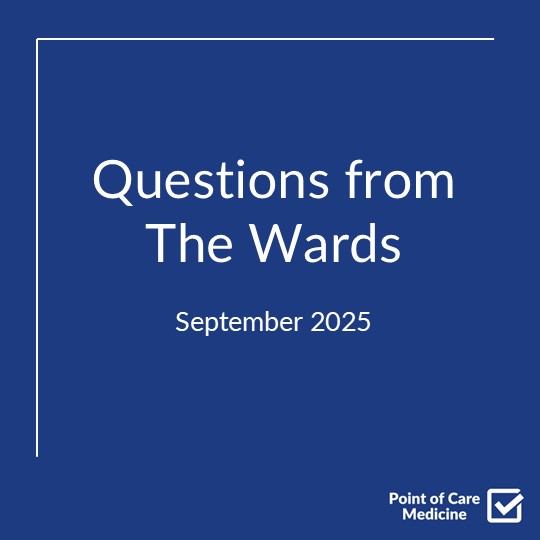




.png)
